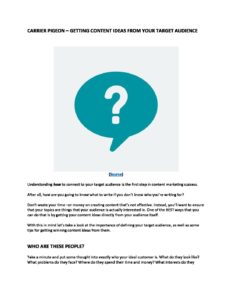Understanding how to connect to your target audience is the first step in content marketing success.
After all, how are you going to know what to write if you don’t know who you’re writing for?
Don’t waste your time –or money on creating content that’s not effective. Instead, you’ll want to ensure that your topics are things that your audience is actually interested in. One of the BEST ways that you can do that is by getting your content ideas directly from your audience itself.
So where do you start?
There are a great number of ways that you can go about mining your audience for content ideas. From scouring the net to see what issues they’re facing to searching through your FAQ page, there’s no shortage of opportunities for creating relevant and unique content. As another bonus, when the ideas come direct from your customer base, you can be certain –well, almost certain, that they won’t fall flat.
Create content that converts! Here’s a look at the importance of defining your target audience, as well as some tips for getting winning content ideas from them.
Why Your Target Audience Matters
It’s the single biggest mistake that brands both old and new alike make: trying to be everything to everyone.
But with this mindset, a company won’t last for long.
By casting a net that’s too wide, and trying to appeal to everybody, you end up diluting your message, and losing out on your target audience. Your messaging will seem too generic and polished –and risk sounding contrived; and your audience will be able to spot that a mile away.
As a business, your goal should be to stand out from a crowd, not become a part of it.
Take corporate media, for example. They are most concerned with mass appeal. In doing so, their messaging frequently seems watered down and generic.
Now, think about brands that stand out in your mind. There’s a good chance that most, if not all of them, do so because of their clear message and branding. Smart marketers strive to first identify their target audience, and then seek to carve out specific niches and subsets of customers.
No matter what you are selling or saying, your audience is out there somewhere. It is your primary responsibility to locate them and figure out what makes them tick.
This may seem like a herculean task. But it doesn’t have to be. Once you’ve pinpointed exactly who you’re targeting, you’ll be able to a get a lot more specific in every aspect of your marketing. This will prove to be tremendously valuable, enabling you to target your audience a lot more accurately, and allowing you to be certain that your messages resonate with them.
If you’d like to start sourcing ideas from your target audience, here are some steps that you can take to get started.
Who Are These People?
Take a minute and put some thought into exactly who your ideal customer is. What do they look like? What problems do they face? Where do they spend their time and money? What interests do they have? Be specific, what type of persona is your business targeting? Who are you building your product for?
Some marketers find it useful to create a few brand personas and tailor copy specifically to those personas. Not sure where to start? Then check out this article: How to Identify and Speak to Your Customer Personas.
A few factors that you should be considering when defining your ideal customer are:
- Customer demographics such as age, gender, location, and income.
- Where do they spend most of their online time? Determine what social media sites they use and their content consumption habits.
- What type of problems do they face daily? What frustrates them?
The answers to these questions are going to be vastly different from business to business. But once you get a handle on these specifics, you’re going to have a much easier time marketing. This exercise may seem tedious, but it’s one that’ll pay off tremendously over time.
What Problems Does Your Brand Solve?
All of the best products solve a problem for customers, or fill some need –be it genuine or perceived.
Any successful brand is going to fill some void in their customer’s lives.
Your job is to determine which problems your brand solves –or which needs it addressees. With this approach your brand will be able to base its marketing around solving your audience’s problems and empathizing with their pain points –helping you to form that crucial connection.
This tactic is going to allow you to attract a particular group of people. It may also let you to zero in on individuals that are being overlooked by your competition. This could be your chance to step in and win your audience over.
Naturally, you’re going to have to do your research first. Figure out where their pain points are and how your brand intersects with them. This is the simplest and most effective way for your brand to interact with followers and customers.
Tips for Sourcing Content Ideas
Now that you have a pretty good idea about who they are, let’s take a look at some ways to reach out, and get ideas from your target audience.
Simple and Straightforward Social Media
Social media is a virtual treasure trove of information. But like all good treasure hunts, you have to know where to look to find the answers you’re seeking.
Your audience is out there, liking, tweeting, and sharing valuable information. It’s your job to analyze that information and make some meaningful discoveries.
In order to glance at what’s on the minds of your customers, analyze hashtags and follow conversations that are occurring online. See what people are sharing and discussing, and determine how your brand can become part of that conversation.
Set up Google Alerts for your business or brand’s name, and see what your customers are saying on social media. This can be a great way to keep tabs on what’s being said about you, and can prove to be a great source of relevant content inspiration.

Get our Carrier Pigeon - Getting Content Ideas from Your Target Audience Worksheet delivered right to your inbox.
Ask Lots of Questions
It’s simple, yet effective –asking your target audience straightforward questions can open up a world of content inspiration. Additionally, the answers to these questions could influence your marketing strategy or the direction of your business at large –so make sure you take the time to tap into your audience to see what they’re thinking.
If you currently have an engaged social media following or email list –then you’re good to go! Simply post questions to gauge where your audience’s interests lie. These questions can lead to conversations and engagement, which in turn leads to a better understanding of your target audience.
Now that you have your target audience narrowed down. Let’s discuss how you can glean ideas for content from them.
Quora Is Full of Questions
In case you haven’t heard of it yet, Quora is an information-focused site where people can and respond to questions. With more than 300 million monthly users and 400,000 topics, there is most certainly some useful information regarding your products or services to be gleaned from this site.
The rating system is very similar to Reddit, where there is a credit-based voting system, where the best answer is featured on the top.
As a marketer, you can do the following on Quora:
- Publish content similar to LinkedIn’s publishing platform.
- Collaborate with industry influencers by targeting specific questions to Quora users.
- Research topics and keywords related to your business.
When it comes to unearthing content ideas, Quora can be utilized a couple of different ways. The first is by merely lurking through the various Q&As that are relevant to your industry. Is there anything in particular that people are asking consistently? Are there any ‘pain points’ that you can identify?
The other strategy is to ask questions yourself. Start a conversation with people that you consider your target audience. Try to figure out what their interests are and topics they would like to learn more about.
Remember, we’re dealing in content marketing here, so the idea is not to overtly pitchy (or pitchy at all). You are going to want to approach this endeavor with grace and humility, with the interest of helping your customers.
Reddit Is Where It’s At
Standing tall as the third most-visited website in the U.S., Reddit can be so much more than a great place to waste time. Indeed, mining this terrific resource can help source content ideas for blog posts, workshops, online courses and more.
The traffic on Reddit is valuable in and of itself; however, the engagement is what makes is exceptionally valuable. The site boasts 43% percent more engagement than Facebook according to statistics published in The Next Web.
The site has more than 1.2 million subreddits –topic-specific forums, and posts regularly receive hundreds –even thousands of comments.
To find topics, head over to subreddits and start looking for topics in your niche. Use Reddit’s search box to find them. Once you’ve located a promising subreddit, use the search function again to type in phrases that people who are struggling with something might use. Here are a few examples:
- “How do you”
- “How can I”
- “I can’t figure out”
- “Help”
- “Suggestions”
- “Biggest challenge”
- “Tips”
These search terms will bring up threads dealing with issues that people are facing –and the results will prove to be a gold mine when it comes to content ideas. The issues that pop up in the results will give you some great ideas on things that people are struggling with, giving you great ideas for creating content on topics that your audience will be interested in.
Frequent Forums and Other Online Groups
This is going to be different for every industry and niche. The sites you visit are going to depend significantly on where your target audience hangs out on the web.
For some individuals, Facebook Groups are going to be a success. Others may have a hard time finding an engaged audience and instead may lean more towards LinkedIn.
The idea behind using forums or groups to research and find relevant topics is not unlike that of Reddit or Quora. You first need to put in the research to discover where your audience is having a discussion online, and then you need to mine that resource for relevant information.
Take Facebook Groups for example. They’re a great place to connect with other like-minded people. Furthermore, these web properties are becoming increasingly crucial for businesses looking to cultivate a community.
If you are looking to start the conversation and provide a location for your target audience to have that conversation, then Facebook Groups may be the right choice for you.
One benefit of hosting your own group instead of searching third party forums is that you are able to control the narrative of the conversation. Even better, once you have developed an engaged audience, you’ll be able to ask them questions in the form of polls and surveys. This can go a long way in identifying topics that they would be interested in reading.
That being said, let’s go into more detail about online polls and how they can help you.
Conduct Online Polls
This method can be executed a couple of different ways. First, you could simply post a question on your social media profiles. For example, “What type of content are you interested in reading from us?”
If you’re okay with open-ended replies, this method works fine. However, if you have a better idea of what type of content would likely move your audience, you could instead create a poll and list a few options.
Twitter, Facebook, Instagram, and LinkedIn all allow you to add polls to your timeline or story. This is a great way to not only engage your audience but to also get some rapid data as to their interests and opinions.
As a third option, you could use your sub-list to email your audience and ask them outright what they would like to see more of from your company. Ask them what topics they enjoy the most and which ones they would like to see more of.
Check Your FAQ Page and Support Tickets
If you have an FAQ page, this can prove to be another great source of ideas for content. This is especially the case if you base your FAQs on actual questions that you’ve been asked.
If you haven’t done so already, you’ll also want to start keeping track of your support ticket requests. Consider categorizing them, and creating a list to see if you notice any recurring tickets. If you see the same request come through a few times, you’ll know that there’s an issue that you could address through an article or video.
Likewise, if you have a customer service team –have them write down the questions that they’re being asked, then evaluate them later.
Evaluate Your Content
Of course, it’s also a good idea to evaluate your content before you publish it.
Consider using a tool like MarketMuse to analyze your content and see what it recommends. It’s a handy tool that’ll help you to see how well your existing content is performing –and give you ideas for new content that’ll perform well.
As you can see, there are several options for generating content from your target audience. It really doesn’t matter if you have established channels with a ton of followers or not.
The most important part of the process is understanding who your target audience is and figuring out where they hang out online. From there, it’s all about utilizing the search functions or starting the conversation.
Creating good content takes time, effort, and research. The more time you put into these initial steps, the more productive and engaging your content will be.
At Carrier Pigeon, we can help YOU to promote your blog content. It’s a big world out there; and we’ll help you get your message out to your intended audience. Reach out today to learn more.

Get our Carrier Pigeon - Getting Content Ideas from Your Target Audience Worksheet delivered right to your inbox.








1 thought on “Carrier Pigeon – Getting Content Ideas from Your Target Audience”